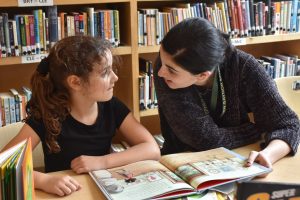What is the difference between Phonological and Phonemic Awareness?
By The Reading Department (Sloan Shapiro, Kristi Evans, and Robyn Kramer)

Phonological awareness covers many skills. (One of them is phonemic awareness.) Children who have phonological awareness are able to identify and make oral rhymes, can clap out the number of syllables in a word, and can recognize words with the same beginning sounds like ‘monkey’ and ‘money.’ Phonemic awareness refers to the specific ability to focus on and manipulate individual sounds (phonemes) in spoken words. For example, the word ‘cat’ has three phonemes: /c/ /a/ /t/ and the word ‘frog’ has four phonemes: /f/ /r/ /o/ /g/. Children who are phonemically aware can blend the sounds /d/ /o/ /g/ into the word ‘dog’, identify the second sound in the word ‘spider’ /p/, and delete the last sound in ‘cart’ and say “car.”
Why are Phonological Awareness (PA) skills important? They help build the neural systems for reading. In Overcoming Dyslexia, Dr. Sally Shaywitz writes, “People are often surprised to learn that it is phonemic awareness and not intelligence that best predicts ease of learning to read.”
What activities can I do at home to improve my child’s PA skills?
- Rhyming – Read Nursery Rhymes. Play simple rhyming games with your child, such as taking turns coming up with words that rhyme. For example, mat and hat.
- Sentence Segmentation – Use tokens or beads to count the number of words heard in a sentence. The elephant ran fast (4 words)
- Syllables – Have your child hop or clap once for every syllable. Pancake (2), watermelon (4). Reverse syllables like cobweb/webcob, or add syllables to a word. (Add star to the beginning of fish – starfish.)
- Phoneme Manipulation – Ask your child, “What is the first sound you hear in van?” “What is the last sound you hear in desk?” “What sound is the same in fix, fall and fun?” “What word is /b//i//g/?” “Put these sounds together to make a word /f//l//o//p/.” “Let’s think of all the words that begin with /s/.”
